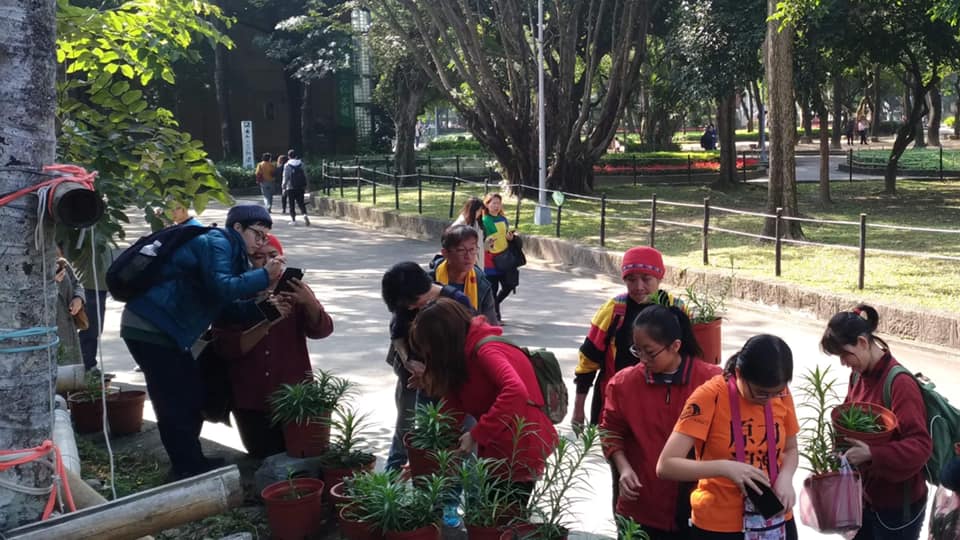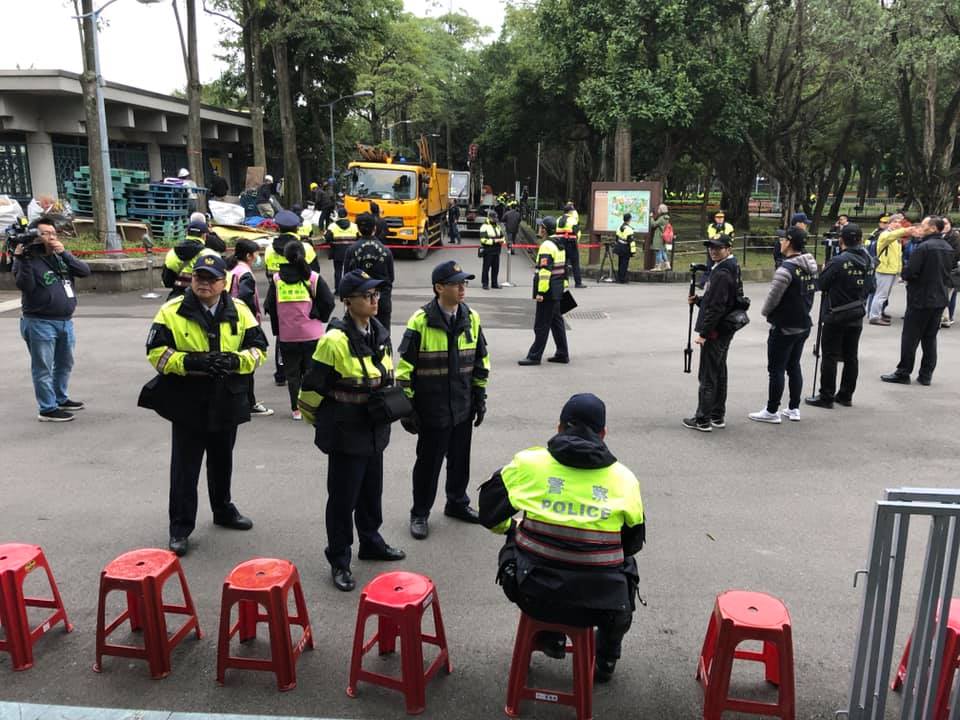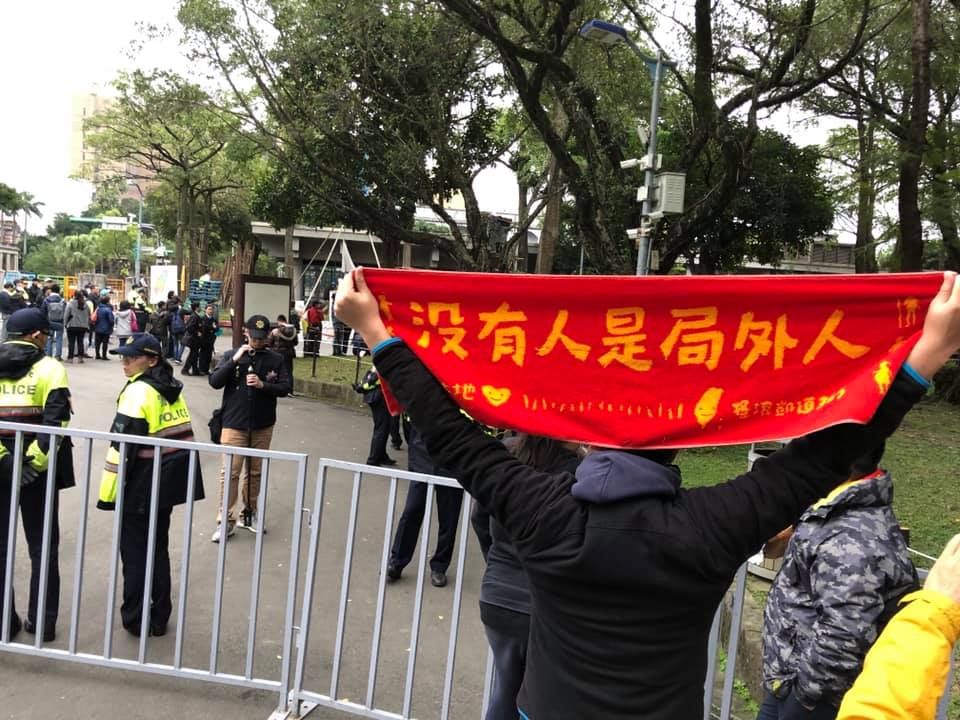by Brian Hioe
語言:
English
Photo Credit: Sabrina Lim/Facebook
TAIPEI CITY POLICE dismantled the occupation encampment of indigenous protesters outside Exit 1 of the NTU Hospital station earlier today. Indigenous protesters, however, vow to continue to occupy. Today was the 699th day of the occupation and this was the third dismantlement of the occupation which has occurred to date.
Having received an advance warning from police that they would dismantle the occupation today, indigenous occupiers previously relocated 300 lilies planted in their encampment to the Taipei Fine Arts Museum, where indigenous occupiers currently have an exhibit as part of the Taipei Biennial. Police stated that while they would dismantle the encampment, they would not forcibly remove occupiers. Set up in the encampment had been tents, traditional indigenous structures, a small stove, artwork, and placards featuring information about the demands of the occupation and the broader history of Taiwanese indigenous.
 Indigenous occupiers and supporters relocating lilies planted in their encampment to the Taipei Fine Arts Museum. Photo credit: 一起陪原住民族劃出回家的路/Facebook
Indigenous occupiers and supporters relocating lilies planted in their encampment to the Taipei Fine Arts Museum. Photo credit: 一起陪原住民族劃出回家的路/Facebook
As a result, indigenous occupiers will likely continue to stay, the occupation having persisted in some form on Ketagalan Boulevard in front of the Presidential Office or outside of the Shandao Temple MRT for close to two years. The indigenous occupation is one of several political occupations which have been present in the Shandao Temple area over the last few years, including the Free Taiwan Party/Alliance of Referendum for Taiwan’s pro-independence occupation, and the occupation by the 800 Heroes anti-pension group. The Shandao Temple area sees a number of such occupations because of the cluster of government buildings in the area, including the Presidential Office, Legislative Yuan, Executive Yuan, and Control Yuan.
Indigenous occupiers have stated that they believe police actions were timed to coincide with a period in which a number of key members of the occupation would not be present, such as documentary film director Mayaw Biho and singer-songwriter Nabu Husungan Istanda. It is also possible that police did not want the occupation lasting over 700 days, or just felt the need to assert their authority against the occupation. It is unknown if the orders for the eviction came from Taipei city mayor Ko Wen-je or perhaps the central government, most likely the latter, seeing as Ko later publicly defended the police action. However, the use of police force against the indigenous occupation has generally been disproportionate compared to other occupations present in the Shandao Temple area over the last two years.
The occupation demands the return of indigenous traditional territories which are private property. While the Tsai administration formally apologized on behalf of the ROC government for mistreatment of indigenous and restored traditional territories which are public property, this did not include private property. As a result, indigenous groups still face the issue of private development companies building on traditional territories. The occupation began shortly after the Tsai administration’s official apology to Taiwanese indigenous and protests by indigenous groups against it for its halfway measures.
 Photo credit: 一起陪原住民族劃出回家的路/Facebook
Photo credit: 一起陪原住民族劃出回家的路/Facebook
In particular, indigenous groups feel betrayed by the Tsai administration, because it previously indicated that it would restore indigenous traditional territories as a whole, but then later only followed through with part of this promise. Singer-songwriter Panai Kusui, another key figure of the occupation, and a longtime activist with close ties to contemporary Taiwanese youth activism, previously performed at Tsai’s inauguration.
Although the Tsai administration has made token gestures, such as visiting the occupation shortly after her official apology, the Tsai administration has generally remained silent on the issue. Likewise, the issue has not made headway within the legislature, despite some false starts, due to the lack of interest of mainstream political parties in pursuing the issue, perhaps with the exception of the NPP. Indeed, during the clearing today, the NPP’s three Taipei city councilors, visited the occupation site to express support for occupiers—although this was likely also aimed at deflecting criticisms against the NPP for a poor record on indigenous issues after a proposal regarding indigenous representation was voted down at their first general assembly as a political party.
This broader silence occurs despite numerous high-profile expressions of support for the cause by indigenous activists and their allies, as observed in public statements at the Golden Melody Awards, Taiwan’s most prestigious music award, or the ubiquity of the occupation’s slogan, “No One is an Outsider” (沒有人是局外人), and the incorporation of the occupation into the Taipei Biennale this year.
 Photo credit: 一起陪原住民族劃出回家的路/Facebook
Photo credit: 一起陪原住民族劃出回家的路/Facebook
Activities by the occupation in the last two years have included teach-ins, screenings, performances by Panai and other high-profile indigenous musicians, such as Sumin, and other activities. Panai recorded during two albums that time as well, including one recorded on Ketagalan Boulevard itself.
In the meantime, the issue with scarcely go away. Indigenous occupiers have persisted with their occupation despite previous dismantlements of their encampment by police, though it is possible that indigenous occupiers may relocate the occupation to another area near Shandao Temple. But it still remains to be seen how to raise awareness of the issue among the broader public.

